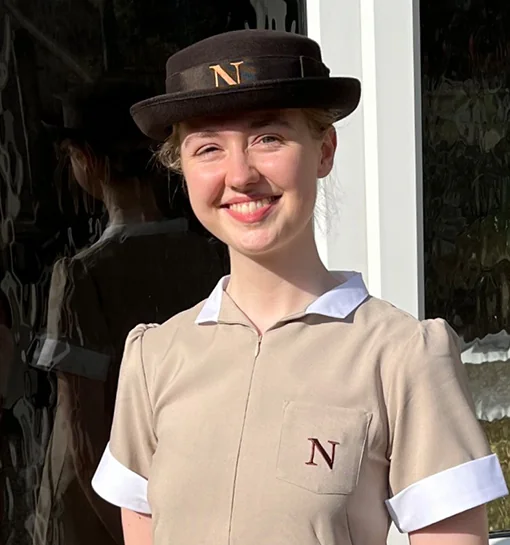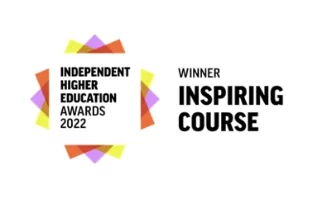International Stammering Awareness Day: how early years practitioners can support children with stammers
21 October 2022

Stammering is a neurological condition that makes it physically difficult for someone to speak. Around 8% of children will stammer at some point and for about 2% of adults, it will be a lifelong condition, according to Stamma – the British Stammering Association dedicated to supporting children and adults in the UK who have stammers.
Second-year student Evi has a stammer. In support of International Stammering Awareness Day on 22 October 2022, Evi shares with us the challenges she faces, how she uses her Norland training to support a child’s communication, and how early years practitioners can help children who have a stammer.
“I’m Evi and I’m turning 20 in October, having just started my second year at Norland in Set 45. I’m originally from Portsmouth and I grew up with a really strong connection to the armed forces, which sparked my interest in global affairs. This meant I almost attended the University of Cambridge before eventually choosing Norland. I’ve always wanted to work with children after being inspired by my Year 2 teacher and wished to become anything from a midwife to a speech therapist before finally learning about the role of the nanny.

My stammer
Communication is so important. It allows us to participate in the social world, and I know this more than others because I have a stammer. A stammer is a condition that affects the nervous system which inhibits the ability to physically speak and, according to research, the likelihood that I developed my stammer is because of genetics.
My stammer stops at the back of my throat at a particular word, meaning that I could keep stuttering for hours unless I come up with something different. My mum refers to it as a brick wall and because it was so obvious growing up, it became a barrier to my everyday development. I struggled to learn, make friends, and grow confidence, and it hit a real low in Year 4 when I couldn’t even say hello in response to the register.
Growing up, my parents made me constantly aware that my father also had a stammer when he was younger and while he grew out of it quickly, it felt so comforting to know that someone understood the pain an impediment like that causes.
After we finished the Communication, Language and Literacy degree module, I instantly knew that I had to share my experiences with a speech impediment and how it causes a domino effect on the rounded development of a growing child.
One theorist we discussed, Tomasella, claimed that there are three motivations to a child searching out conversation and I noticed immediately that this isn’t applicable for people like myself. We don’t seek interaction between our peers because individuals with stammers balance a system of higher levels of anxiety and poorer qualities of life.
Without having back-and-forth conversations between a child and a more knowledgeable other, it’s been shown that we can’t learn the structure of conversation or begin the building of a range of vocabulary. When we voluntarily choose not to engage out of fear, people with stammers can’t explore productive language or investigative comments which means we have a significant disadvantage compared to our ‘normal speaking’ friends.

Supporting children with stammers in settings
Based on personal experiences, schools often struggle to inform and train their staff fully about stammers and it’s down to the teacher to educate themselves about speech impediments. Friends often make fun of it, not realising that unless intense speech therapy occurs, it may be impossible to overcome.
This subject was so important for me to discuss as it was a means to bring the subject to some of the most respected people in early years education in the UK – a subject which is often pushed to the back of conversations.
Stammers are not black and white when it comes to early years provision. It’s not considered a disability and so there’s no funding for children that struggle. However, an individual with an impediment so severe will often qualify under discrimination laws and settings such as schools have to make reasonable adjustments.
Speech therapy is often the only source of support for a child with a stammer. It’s intensive, means being removed from classes on a weekly basis and applying for a space under the National Health Service (NHS) is like playing the lottery. I, unfortunately, didn’t win.
1 in 12 children in the UK will be impacted by a speech impediment at some point in their adolescence, and based on what my dad has revealed, not much has changed since my father’s diagnosis in the 1970s.

My advice for early years practitioners on supporting children with stammers
If I had to give one piece of advice for early years practitioners, it would be patience! There’s nothing I fear more, as a child that couldn’t even say hello to the morning register, than watching someone get irritated and annoyed as you struggle to form a simple sentence.
According to the fantastic charity, Stamma, early years practitioners should focus on what’s being said rather than the way it’s being communicated – this could culminate in asking questions that can be answered with yes or no, this or that and allows a child to engage in conversations without creating that fear.
You may have seen the Educating Yorkshire episode where a teacher supports his student through an entire speech without stammering with the use of music. Patience is key with experimenting differentiation. Playing music while talking doesn’t help me but singing a song or a rhyme where I’m expected to follow a pace with words that I have experience with already, removes any kind of speech impediment I may have.
It’s all about researching, liaising with speech therapists and parents, and discovering which methods will reduce that anxiety and remove that neurological barrier to allow effective communication.
Organisations such as Stamma (the British Stammering Association) and Action for Stammering Children provide useful resources and can point early years practitioners in the right direction.
During the time when my stammer was destroying my learning and my relationships, I was denied speech therapy under the NHS. My parents were the best and understood how badly my mental health was being affected and decided they had to do something quickly. As I mentioned, music didn’t help me, and so they took a gamble and used a blindfold. I often (and still do!) made my stammer worse by focusing on the physical reaction it caused. By removing an entire sense, I was able to block out a source of stimulation. This is known as sensory foregrounding.
By blocking out the sense of sight, I could completely detach myself from the feedback it gave to my brain. By forcing my brain to entirely focus on my speech and articulation, it produced a higher level of concentration for me and conventionally aided in my development of vocabulary, literacy fluency and speech recognition. Fast forward 10 years, and while researching how the blindfold helped me, it’s since been scientifically shown to support the development of communication, language and literacy.

My research into stammers
My research into this area really surprised me. Protoconversations (interactions between an adult and a baby that includes words, sounds and gestures) are considered to be the originators of conversation. They start from birth and are the types of communication where you talk to your baby. By partaking in these types of conversation, a child begins to understand how to take turns, learning rhythm and patterns which support them in social situations for their entire life.
We continue to use protoconversations to learn how to socialise throughout our childhood, but my research suggested that by introducing a barrier like a speech impediment, children can fall back on their development. We learn social cues, the meaning of silences within conversations and rhythm by practising those ‘fake’ conversations. Even without considering the impact of anxiety due to the stammer, this can make children even more wary of using their voice thus harming their confidence and making it even more difficult to engage in everyday dialogue.
But there is hope! In the US, almost half of all children that are recognised as needing additional speech support receive this support in the form of therapy and this can surely be similar to the work of the NHS in the UK.
The NHS mentions that children often grow out of speech impediments, and whilst that’s somewhat true for many other people, it was the support of my parents that allowed me to become confident enough to focus on working on how to communicate (as I had missed out on so many conversations) and to take the lead and get as much support as I possibly could get! This is the confidence that I needed to go to university and without it, I probably wouldn’t have attempted to apply.
My time at Norland has been amazing! Whilst my stammer is something that I can manage through strategies (such as stopping, taking a breath and redoing what I wanted to say) and my ability to converse, I experience patience and understanding from my friends and lecturers which is such a stark difference to before. More importantly, I’m so grateful to have had the chance to share my story through writing this blog and those of millions of other children in the UK.”








